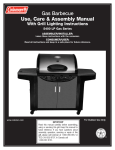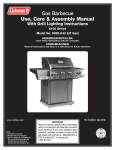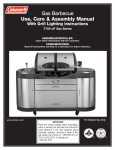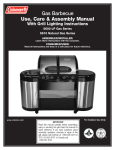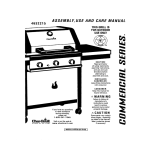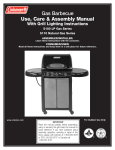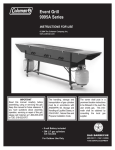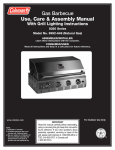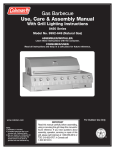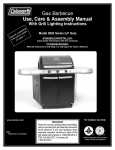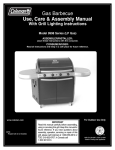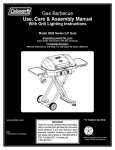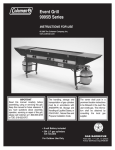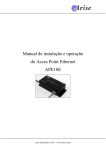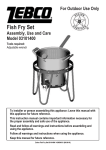Download Coleman 9947A726 Specifications
Transcript
Gas Barbecue Use, Care & Assembly Manual With Grill Lighting Instructions Model 9947A726 ASSEMBLER/INSTALLER: Leave these instructions with the consumer. CONSUMER/USER: Read all instructions and keep in a safe place for future reference. IMPORTANT Read this manual carefully before assembling, using or servicing this grill. Keep this manual for future reference. If you have questions about assembly, operation, servicing or repair of this grill, please call Coleman at 1-800-835-3278 or TDD: 316-832-8707. In Canada call 1-800-387-6161. For Outdoor Use Only CERTIFIED ® ® ANSI Z21.58a-1998 / CGA 1.6a-M98 OUTDOOR COOKING GAS APPLIANCES WARNING Contents General Safety Information. . . . . . . . . . . . . . . . . . . . . . . . . . . . . . . . . . . . . 2 General Installation. . . . . . . . . . . . . . . . . . . . . . . . . . . . . . . . . . . . . . . . . . . 3 Electrical Attachments . . . . . . . . . . . . . . . . . . . . . . . . . . . . . . . . . . . . . . . . 4 LP Fuel Connections Other Than Portable L.P. Cylinders . . . . . . . . . . . . . 4 Natural Gas Connections . . . . . . . . . . . . . . . . . . . . . . . . . . . . . . . . . . . . . . 4 Portable L.P. Gas Barbecue Cylinders . . . . . . . . . . . . . . . . . . . . . . . . . . . . 4 Hose and Regulator.. . . . . . . . . . . . . . . . . . . . . . . . . . . . . . . . . . . . . . . . . . 5 Transporting the Cylinder . . . . . . . . . . . . . . . . . . . . . . . . . . . . . . . . . . . . . . 5 Filling and Purging Type 1 L.P. Gas Cylinders . . . . . . . . . . . . . . . . . . . . . . 6 Purging and Evacuating Devices for L.P. Gas Cylinders with Type 1 Cylinder Valves . . . . . . . . . . . . . . . . . . . . . . . . . . . . . . . . . . . 6 Assembly/Set up. . . . . . . . . . . . . . . . . . . . . . . . . . . . . . . . . . . . . . . . . . . . . 7 Connecting Type 1 L.P. Gas Cylinders . . . . . . . . . . . . . . . . . . . . . . . . . . . 12 Leak Testing . . . . . . . . . . . . . . . . . . . . . . . . . . . . . . . . . . . . . . . . . . . . . . . 12 Fixing a Fuel Leak . . . . . . . . . . . . . . . . . . . . . . . . . . . . . . . . . . . . . . . . . . 13 Start-Up Check List. . . . . . . . . . . . . . . . . . . . . . . . . . . . . . . . . . . . . . . . . . . 13 Lighting Instructions . . . . . . . . . . . . . . . . . . . . . . . . . . . . . . . . . . . . . . . . . 13 Lighting Main Burners. . . . . . . . . . . . . . . . . . . . . . . . . . . . . . . . . . . . . . . . 14 Lighting Side Burner . . . . . . . . . . . . . . . . . . . . . . . . . . . . . . . . . . . . . . . . . 14 Shutting Off the Grill . . . . . . . . . . . . . . . . . . . . . . . . . . . . . . . . . . . . . . . . . 14 General Use and Correct Burner Flames. . . . . . . . . . . . . . . . . . . . . . . . . 15 Grilling Tips and Hints. . . . . . . . . . . . . . . . . . . . . . . . . . . . . . . . . . . . . . . . 15 In Case of Grease Fire . . . . . . . . . . . . . . . . . . . . . . . . . . . . . . . . . . . . . . . 16 Cooking Methods . . . . . . . . . . . . . . . . . . . . . . . . . . . . . . . . . . . . . . . . . . . 16 Cleaning the Venturi . . . . . . . . . . . . . . . . . . . . . . . . . . . . . . . . . . . . . . . . . 16 Cleaning and Maintenance. . . . . . . . . . . . . . . . . . . . . . . . . . . . . . . . . . . . 16 Moving and Storage . . . . . . . . . . . . . . . . . . . . . . . . . . . . . . . . . . . . . . . . . 17 Troubleshooting. . . . . . . . . . . . . . . . . . . . . . . . . . . . . . . . . . . . . . . . . . . . . 17 For Your Additional Safety. . . . . . . . . . . . . . . . . . . . . . . . . . . . . . . . . . . . . 18 Replacement Parts List . . . . . . . . . . . . . . . . . . . . . . . . . . . . . . . . . . . . . . 19 Warranty . . . . . . . . . . . . . . . . . . . . . . . . . . . . . . . . . . . . . . . . . . . Back Page General Safety Information This manual contains important information about the assembly, operation and maintenance of this product and system. General safety information is presented in these first few pages and is also located throughout the manual. Particular attention should be paid to information accompanied by the safety alert symbols: “ DANGER”, “ WARNING”, “ CAUTION”. Keep this manual for future reference and to educate new users of this product. This manual should be read in conjunction with the labeling on the product. Safety precautions are essential when any mechanical or propane fueled equipment is involved. These precautions are necessary when using, storing, and servicing. Using this equipment with the respect and caution demanded will reduce the possibilities of personal injury or property damage. The following symbols are used extensively throughout this manual. Always heed these precautions, as they are essential when using any mechanical or fueled equipment. DANGER DANGER indicates an imminently hazardous situation which, if not avoided, will result in death or serious injury. WARNING WARNING indicates a potentially hazardous situation which, if not avoided, could result in death or serious injury. CAUTION 2 CAUTION indicates a potentially hazardous situation which, if not avoided, may result in minor or moderate personal injury, or property damage. IF YOU SMELL GAS: 1. Shut off gas to the appliance. 2. Extinguish any open flame. 3. Open lid. 4. If odor continues, immediately call your gas supplier or your fire department. 5. NEVER use Natural Gas in a unit designed for Liquid Propane (L.P.) Gas. WARNING FOR YOUR SAFETY: 1. DO NOT Store or use gasoline or other flammable vapors and liquids in the vicinity of this or any other appliance. 2. An L.P. cylinder not connected for use shall NOT be stored in the vicinity of this or any other appliance. 3. NEVER use Liquid Propane (L.P.) Gas in a unit designed for Natural Gas. WARNING Combustion by-products produced when using this product contain chemicals known to the State of California to cause cancer, birth defects, or other reproductive harm. DANGER • FOR OUTDOOR USE ONLY. NEVER operate grill in enclosed areas, as this could lead to gas accumulating from a leak, causing an explosion or a carbon monoxide buildup which could result in injury or death. DO NOT use in garages, breezeways, sheds or any enclosed area. (Fig. 1) • NOT FOR USE BY CHILDREN. (Fig. 2) • If these instructions are ignored, a hazardous fire or explosion could result in physical injury, death or property damage! WARNING • DO NOT move grill while it is lit. (Fig. 3) • Keep outdoor cooking gas appliance area clear and free from combustible materials, gasoline and other flammable vapors and liquids. (Fig. 4) WARNING • NEVER place more than 15 pounds on a side table or a side burner. DO NOT lean on grill. (Fig. 5) • NEVER use charcoal briquettes or lighter fluid in a gas grill. (Fig. 6) • Grill is hot when in use; to avoid burns, DO NOT touch any hot grill surface. Keep children and pets away from hot grill. (Fig. 7) • NEVER leave the grill unattended while it is in use. (Fig. 8) • It is your responsibility to assemble, install, operate and care for your gas grill properly. • DO NOT vent propane vapor from the cylinder before taking it to be refilled. • DO NOT use gas grill indoors or store any propane cylinder(s) indoors, including in the garage, breezeways, sheds or enclosed areas. • Under some circumstances, propane may lose the distinctive odor that was added. Keep the service valve closed and plugged or capped (as recommended by the manufacturer) when the cylinder is not connected to the appliance, including “empty” cylinders. Other strong odors may hide or mask the odor of propane. Colds, allergies, sinus congestion, and the use of tobacco, alcohol or drugs may impair your ability to detect the odor of propane. General Safety Information (cont.) 1 3 2 4 7 24" 8 5 6 General Installation • Installation must conform with local codes or, in the absence of local codes, with either the National Fuel Gas Code, ANSI Z223.1 (USA), CAN/CGA-B149.1, Natural Gas Installation Code or CAN/CGA-B149.2, Propane Installation Code (Canada). To check local codes, see your local L.P. gas dealer or natural gas company listed in the Yellow Pages for recommended installation procedures and regulations. WARNING 9 Clear 24" (60cm) 24" (60cm) This appliance is not to be installed in or on a recreational vehicle and/or boat. Follow these safety rules before each use: 1. Always maintain a minimum clearance of 24 inches or 60 cm from all sides of grill to any combustible construction. (Fig. 9) 2. Never locate grill under an unprotected combustible material or overhang which is connected to a building. (Fig. 9a) 3. Do not obstruct the flow of combustion and ventilation air. 4. Keep the ventilation opening(s) of the cylinder enclosure free and clear from debris. 5. Grill should be level and not facing directly into wind. 24" (60cm) REPRESENTATIVE ILLUSTRATION 9a WARNING Keep any electrical supply cord away from any heated surface. During assembly of grill and when attaching or replacing the L.P. gas cylinder, insure that the gas supply hose is free of kinks and is at least 3" away from hot surfaces such as the grill housing. 3 Electrical Attachments When using an electric attachment with grill, follow specification and warning statements accompanying the attachment. IMPORTANT: If using an external electrical source, the installed appliance must be electrically grounded according to local codes or, in the absence of local codes, with the National Electrical Code, ANSI/NFPA 70 or the Canadian Electrical Code CSA C22.1. WARNING Electrical Grounding instructions: An appliance equipped with a three-prong (grounding) plug is for your protection against shock hazard and must be plugged directly into a properly grounded three-prong receptacle. DO NOT remove grounding prong from a three-prong plug. Longer detachable power-supply cords or extension cords must be used with care. The marked electrical rating of the cord set or extension cord must be at least as great as the electrical rating of the appliance. If the appliance is of the grounded type, the extension cord should be a grounding-type 3-wire cord. Use outdoor extension cords with a surface marked with suffix letters “W-A” and with a tag stating “Suitable for Use with Outdoor Appliances”. Keep the connection to an extension cord away from water and off the ground. Arrange the cord so that it will not drape over the countertop or tabletop where it can be pulled on by children or tripped over unintentionally. Never clean any electrical product with water or cleaning fluids. Store electrical products indoors and out of reach of children when not in use. DO NOT allow cord to touch any hot surfaces which could melt insulation. LP Fuel Connections Other Than Portable L.P. Cylinders CAUTION • This section applies to L.P. Gas (Propane) Grills and only where propane gas is to be piped to the grill. • Natural gas can be used only with grills which have been equipped for use with natural gas. If the appliance is for connection to other than an L.P. cylinder (consult the Assembly Instructions) the gas connections must be made by a qualified installer or a licensed plumber. The gas supply line must not be installed by the consumer. The maximum inlet supply pressure is 13.0" w.c. for propane gas. The specified supply pressure is 11.0" w.c. for propane gas. Natural Gas Connections WARNING • Gas supply system must be installed in accordance with the U.S. National Fuel Gas Code. • This appliance and its individual shut off valve must be disconnected from the gas supply piping system during any system pressure test in excess of 1/2 PSI (3.5 KPA). • Use a system manual shut off valve to shut off the gas supply to this gas appliance before continuing with installation procedures. The maximum inlet supply pressure is 10.5" w.c. for natural gas. The specified supply pressure is 7.0" w.c. for natural gas. WARNING A liquid propane tank, not connected for use with this gas barbecue, shall not be stored in the vicinity of this or any other appliance. Installation and provision for combustion and ventilation air must conform with the National Fuel Gas Code, ANSI Z223.1, or CAN/CGA-B149.1, Natural Gas Installation Code, or CAN/CGA-B149.2, Propane Installation Code. Connections must comply with local requirements and are the sole responsibility of the person performing the work. A certified plumber must make connection to gas source. Portable L.P. Gas Barbecue Cylinders Liquefied Petroleum gas (abbreviated L.P. gas or propane), is highly flammable. It becomes liquid when stored under high pressure inside a cylinder and vaporizes when released. L.P. gas is heavier than air and tends to collect in low areas. It is important that there are no leaking connections on your gas grill that could cause a fire or explosion (see “LEAK TESTING”, Pg. 12). Portable LP gas grills require a fuel delivery system which is comprised of a valve [A], a hose [B], a regulator [C] with vent hole [G], an L.P. gas supply cylinder [D], a Type 1 coupling nut [E] and a Type 1 cylinder valve [F]. (Fig. 10). Illustration in Fig. 10 is for description purposes only. The valve assembly for this grill is of a different configuration. WARNING Your new barbecue grill is equipped with a Type 1 coupling nut [E]. DO NOT attempt to connect to any other L.P. cylinder not equipped with a mating Type 1 cylinder valve [F]. This grill is not to be used with any other cylinder connection device. 10 A THE PIPING SYSTEM MUST BE INSTALLED IN ACCORDANCE WITH NATIONAL FUEL GAS CODE IN THE USA, INCLUDING: D 1. The appliance and its individual shut-off valve must be disconnected from the gas supply piping system during any pressure testing of that system at test pressures in excess of 1/2 psi (3.5 kPa). 2. The appliance must be isolated from the gas supply piping system by closing its individual manual shut-off valve during any pressure testing of the gas supply piping system at test pressures equal to or less than 1/2 psi (3.5 kPa). B C E 4 F G Portable L.P. Gas Barbecue Cylinders (cont.) DANGER • DO NOT insert any foreign objects into the valve outlet. You may damage the valve. A damaged valve can cause a leak, which could result in explosion, fire, severe personal injury or death. WARNING • Cylinders must be stored outdoors out of the reach of children and must not be stored in a building, garage or any other enclosed area. (Fig. 11) Cylinder Specifications • Any L.P. gas supply cylinder used with this grill must be approximately 12 inches diameter and 18 inches high. The maximum fuel capacity is 80% and is approximately 20 pounds of propane. • The maximum weight of a properly filled cylinder will be approximately 38 pounds (47.7 lbs. nominal water capacity). • The L.P. cylinder must have a shut-off valve terminating in a Type 1 L.P. gas cylinder valve outlet (see item [F], Fig. 10, pg. 4). Portable L.P. Gas Barbecue Cylinders (cont.) CAUTION Have the gas dealer weigh cylinder after filling to ensure that the cylinder is not overfilled. Hose and Regulator The Type 1 connection system has the following features: 1. The system will not allow gas to flow until a positive connection has been made. NOTE: The cylinder control valve must be turned off before any connection is made or removed. 2. The system has a thermal element that will shut off the flow of gas in the event of a fire. 3. The system has a flow limiting device which, when activated, will limit the flow of gas to 10 cubic feet per hour. 4. NEVER use grill without leak testing this connection. WARNING • DO NOT attempt to adjust the regulator as this could create a situation causing personal injury or property damage. 11 The pressure regulator and hose assembly with the Type 1 fitting supplied with the appliance must be used. Do not use another hose and regulator assembly other than the one supplied with the grill or a Coleman replacement pressure regulator assembly. The pressure regulator and hose assembly provided is factory set at an outlet pressure of 11 inches water column (1/2 psi). • Keep the small vent hole in the regulator clean of dirt and debris (see item [G], Fig. 10, pg. 4). • Consult your L.P. gas dealer if you think the regulator is not working properly. WARNING • A Type 1 compatible cylinder with a Type 1 cylinder valve has a back-check valve which does not permit gas flow, until a positive seal has been obtained. • The cylinder must be arranged for vapor withdrawal. It must also include a collar to protect the cylinder valve. A safety relief device having direct communication with the vapor space of cylinder must be provided. This will expel high pressure gas if the cylinder is overfilled or overheated which could result in fire or explosion. • All L.P. gas cylinders used with this appliance shall be constructed and marked in accordance with the specifications for L.P. gas cylinders of the U. S. Department of Transportation (DOT) or the National Standard of Canada, CAN/CSA-B339, Cylinders, Spheres and Tubes for Transportation of Dangerous Goods; and Commission, as applicable; and shall be provided with a listed overfilling prevention device. • Read labels on the L.P. Gas Supply Cylinder. • New cylinders are always shipped empty for safety. • Allow only qualified L.P. gas dealers to fill or repair your L.P. gas supply cylinder. • Inform the gas dealer if it is a new or used cylinder to be filled. • Caution the gas dealer not to overfill cylinder. • After filling, have the gas dealer check for leaks and to see that the relief valve remains free to function. During assembly of grill and when attaching or replacing the L.P. gas cylinder, insure that the gas supply hose is free of kinks and/or damage and is at least 3" away from hot surfaces such as the grill housing. Transporting the Cylinder • Transport only one cylinder at a time. • Transport cylinder in an upright and secure manner with a control valve turned off and the cap in place. • DO NOT transport cylinder in passenger compartment, unless you have an open window ventilation. • DO NOT leave cylinder in direct sunlight or in a high heat area such as a closed car trunk. High heat areas could cause the relief valve to vent gas. • Use a cylinder cap on cylinder valve outlet during transport and when the cylinder is not connected to grill. • Keep cylinder valve closed when not in use. • Take the cylinder directly home after it has been filled. 5 Transporting the Cylinder (cont.) Filling and Purging Type 1 L.P. Gas Cylinders (cont.) WARNING Handle a full cylinder with care. Gas is under high pressure. 13 CGA-510 POL DANGER • NEVER store a spare L.P. gas supply cylinder under the grill body or inside grill enclosure or in the vicinity of any heat producing appliance. (Fig. 12) • NEVER fill the cylinder beyond 80% full. Failure to follow this information exactly could result in an explosion and/or fire causing death or serious injury. Purging and Evacuating Devices for L.P. Gas Cylinders with Type 1 Cylinder Valves 12 CAUTION After purging or filling an L.P. Gas cylinder, DO NOT insert a POL plug into the valve outlet. Insertion of the plug will prevent the back-check from closing. Use ONLY the provided cap and strap attached to the outlet. Close the cylinder valve knob before returning the cylinder to the customer. For proper purging procedures refer to: In the US: Safety Bulletin NPGA# 133, “Purging L.P. Gas Cylinders”, and Safety Bulletin NPGA #130, “Recommended Procedures for Filling Cylinders.” Filling and Purging Type 1 L.P. Gas Cylinders Take these instructions to the L.P. gas dealer. DANGER Purging and filling L.P. Gas cylinders must be performed by personnel who have been thoroughly trained in accepted L.P. Gas industry procedures. Failure to follow this instruction may result in explosion, fire, serious personal injury, or death. • When using cylinder exchange: If your grill is equipped with a Type 1 cylinder, be sure the exchanged cylinder is a Type 1 cylinder, as a 510 POL cylinder will not fit Type 1 regulator. • This tank is easily filled with a standard CGA 510 POL filling connection. (Fig. 13) • New cylinders must be purged before filling. Tell your L.P. Gas dealer if your cylinder is new and has not been previously filled. The L.P. Gas cylinder has a Type 1 cylinder valve with a backcheck module in its outlet which will not permit gas to flow until an evacuation device is installed. To purge the L.P. Gas cylinder, the back-check module must be opened with an evacuation device. 6 A. Hose end valve with a bleed port (Fig. 13): Purging can be accomplished using a hose end valve containing a bleed port which also allows for evacuation without the use of an adapter. B. Hose end valve without a bleed port: When a hose end valve does not have a bleed port, a separate device must be used for evacuation. C. Purging using a Type 1 connection (Fig. 14): L.P. Gas cylinder evacuation can be accomplished during each purging by using a Type 1 connection. The Type 1 valve outlet has an external 1 5/16" ACME right-hand thread which will accept this connection. 14 TYPE 1 Assembly/Set up ■ Remove components from package. Lid Burner Heat TentTM Grease Pan Grates Rotisserie Motor Blister Pack HVR Assembly Warming Rack Ignition Box Side Burner Grease Tray Rotisserie Brackets Rotisserie Spit Middle Divider Back Panel Right Leg Panel Left Leg Panel Top Panel Bottom Panel Left Side Burner Table Door Magnets Right Door Left Door Tank Base Right Side Table Casters Door Handles Towel Bar Trivet Tool Hook 7 Assembly/Set up (cont.) STEP 1 BOTTOM & SIDE PANELS ■ Install three screws from the top and three Hex nuts from below as shown for each side panel. ■ Tighten screws. Panel with hole must be installed as shown. 6 Required STEP 4 TOP PANEL 6 Required ■ Set Top Panel into position on top of Middle Divider. ■ Align holes and handinstall 2 screws. ■ Install screws where Top Panel joins to Sides. ■ Tighten screws. STEP 5 BACK PANEL ■ Install Back Panel as shown. NOTE: Top & bottom row of screw holes have weld nuts. No nuts are required for these screws. STEP 2 CASTERS 6 Required ■ Carefully turn over assembly. ■ Install Casters by threading them into position as shown. NOTE: The Casters with locking arms attach to the front of the assembly. Tank caddy location is on left when assembly is viewed from front. Locking Arm Front of Assembly Back of Assembly STEP 3 MIDDLE DIVIDER ■ Turn over assembly so wheels are down. ■ Install Middle Divider as shown. 2 Required ■ Tighten ALL screws previously hand-tightened. The Cabinet Assembly is now complete. Only Front Casters have locks to secure unit. NOTE: The tall side of the middle divider should be on the front side of the grill. Front of Assembly 8 Assembly/Set up (cont.) STEP 6 INSTALLING IGNITION BOX ■ Install the Ignition Box to the left front leg (on the inside surface) with two self-tapping screws. Two holes are provided for location. STEP 8 LEFT SIDE BURNER (cont.) ■ Insert the post through the mounting hole. 2 Required ■ Reinstall the hairpin cotter. STEP 7 RIGHT SIDE TABLE ■ Remove preinstalled screws from Right Supports. ■ Install Right Side Table. NOTE: Side Table Supports have slots for easy assembly. ■ Tighten securely. POST STEP 9 BURNER ASSEMBLY ■ Remove plastic wrap from the HVR (Hose, Valve, Regulator) before lifting the grill assembly and placing onto the frame. ■ Remove eight sets of hardware, shown below, from the hardware package. Front of unit NUT WASHER STEP 8 LEFT SIDE BURNER ■ Remove preinstalled screws from Left Supports. ■ Install Left Side Burner Table. NOTE: Side Table Supports have slots for easy assembly. ■ Tighten securely. SPACER BOLT 8 Required ■ Install eight (8) spacers by aligning keyed protrusions into the grill side and lock in place with 1/2 turn. ■ Install Grill Assembly as shown. (Two people required.) Front of unit ■ Remove hairpin cotter from the post on the underside of the burner. ■ Install the Side Burner with the Burner Venturi pointing toward the Valve Control Knob location. BURNER VENTURI Bolt Washer Front of Unit ■ Both sections of Hose & Tee must pass through hole in Panel. ■ Eight (8) Bolts, Washers and Nuts are required. Install Bolts through Frame, Spacer and side of the grill. Place Washer and Nut on Bolt and tighten. Install at each corner. Nut 9 Assembly/Set up (cont.) STEP 11 GREASE PAN & GREASE TRAY STEP 9 BURNER ASSEMBLY (cont.) ■ The cardboard packing below the burners cannot be easily removed. It will burn away during the first use. ■ Note: Remove Grease Tray and packing from rear of grill. (This is the storage position of the Grease Tray for shipping.) Grease Tray ■ Grease Pan attaches to Grease Tray with slides. ■ Install Grease Pan as shown. Grease Pan STEP 10 HOSE ROUTING ■ Route Burner Valve at end of Hose through hole in cart end. ■ Insert Orifice Tube into burner, then rotate valve until valve stem goes through hole in side table top. NOTE: Valve must be inserted into Burner Inlet. ■ Slide Grease Tray into Grill. Burner Valve Stem Orifice Tube STEP 12 BURNER TENTS & GRATES ■ Place Burner Heat TentsTM over Burners as shown. ■ Align screw holes of Valve Bracket with holes in brace. ■ Install screws and tighten. 2 Required ■ Install three (3) Grates. ■ Install Valve Knob on Valve Stem. STEP 13 WARMING RACK ■ Install Warming Rack as shown. 10 Assembly/Set up (cont.) STEP 14 BURNER TRIVET STEP 18 DOORS ■ Open Left Side Burner Lid and place Trivet on Burner. ■ Install Left and Right Doors. ■ Insert Bottom Door Pin into hole on Bottom Frame. ■ Hinge Pins are spring-loaded. Pull down to insert Hinge Pin into Top Frame Hole. NOTE: Make sure the 2 holes on each Door are at the top when installed. Top Frame Bottom Frame Hole STEP 15 TOOL HOLDERS 4 Required Bottom Door Pin ■ Install Tool Holders onto front of Left Side Burner and Right Side Table. Top Hinge Pin STEP 19 DOOR HANDLES Tool Hook Towel Bar ■ Remove Screws from Handles. ■ Attach Handles to Doors as shown. ■ Tighten Screws. STEP 16 LOWER DOOR MAGNETS 2 Required ■ Install Lower Door Magnets on Lower Shelf as shown. Lower Door Magnets STEP 20 ROTISSERIE Lower Shelf 4 Required STEP 17 UPPER DOOR MAGNETS 2 Required ■ Install Rotisserie Bracket as shown to right end of grill. (Right Bracket has larger offset.) ■ Install Upper Door Magnets on Top Shelf as shown. Top Shelf ■ Install Rotisserie Bracket to left end of grill. Upper Door Magnets 11 Assembly/Set up (cont.) Connecting Type 1 L.P. Gas Cylinders STEP 20 ROTISSERIE (cont.) WARNING ■ Install Rotisserie Motor & Rotisserie Spit as shown. ■ Make sure Rotisserie Motor is placed on the right side of the grill. NOTE: The Rotisserie Motor will appear to be upside down when installed correctly. This procedure MUST be performed OUTDOORS only! Be sure L.P. cylinder valve is closed. Attach to Grill. Read and follow directions on the cylinder and fuel hose safety tags. CAUTION In the connection process, the grill side of the connection will seal on the back-check in the valve, resulting in a slight resistance. The connection requires about one-half to three-quarters additional turn to complete the connection. To disconnect, turn counterclockwise. Tighten by hand only. DO NOT use tools. NOTE: The threaded Rotisserie handle is designed to be removable. When the Rotisserie is mounted on the grill, the handle will need to be removed to open or close the lid on the Left Side Burner. Replace the Rotisserie Handle before adjusting or removing the Rotisserie. 15 STEP 21 PROPANE CYLINDER SETUP ■ Install Propane Tank Base as shown. ■ Secure the Tank Base to the grill with one self-tapping screw. The hole location is in the front of the Tank Base Flange. 1 Required STEP 22 INSTALLING IGNITION BOX ■ Attach the color-coded wires. ■ Attach RED wires from main burners to terminals A1 and A2. Ignition Box ■ Attach GREEN wires from main burners to terminals B1 and B2. 1. Check that the cylinder valve is closed by turning the cylinder knob clockwise to a full stop. 2. Check that all the grill burner knobs are in the off position. 3. Remove the protective caps from the cylinder valve and coupling nut. NOTE: The coupling nut connects to the large outside threads on the valve outlet. 4. Hold the regulator in one hand and insert the nipple into the valve outlet. Be sure the nipple is centered in the valve outlet. Hand-tighten the coupling nut, taking care not to cross-thread the connection (see Fig. 15). 5. Turn the coupling nut clockwise, tighten to a full stop. 6. Check that the hose has no kinks or sharp bends and clears areas that will become hot during use. Never put strain on the hose where it joins a fitting. NOTE: If you cannot complete the final connection, disconnect the regulator and repeat steps 4 through 6. If you are still unable to complete the connection, DO NOT use this valve and regulator! 7. BEFORE lighting grill, check all connections for leaks using the procedure as shown in Fig. 16 on pg. 13. Leak Testing ■ Attach BLACK wires from main burners to terminals C1 and C2. ■ Attach BLACK wires from Side Burner to terminals D1 and D2. ■ Attach LARGE BLACK wires from Igniter Switch to the pair of terminals on the left side of the Ignition Box. ■ Install the 9-Volt battery with positive (+) terminal as shown on Ignition Box. 12 9-Volt Battery DANGER TO PREVENT FIRE OR EXPLOSION HAZARD: • NO SMOKING. DO NOT use or permit sources of ignition in the area while doing a leak test. • Perform leak tests outdoors only. • NEVER perform a leak test with fire or flame. Leak Testing (cont.) Start-Up Check List WARNING How to Check for Leaks 1. Make a soapy solution of equal parts mild liquid dishwashing detergent and water. 2. Turn off all burner control knobs. 3. Turn on fuel supply. Turn cylinder valve knob counterclockwise (right to left) one rotation. 4. Apply soap solution to connections indicated with arrows in Fig. 16. If bubbles appear at these areas, a leak is indicated. Failure to follow these safety steps before using grill each time could result in a fire that could be hazardous to you, your appliance or property. It is especially important to observe these steps after the grill has been stored, moved or cleaned. 1. Regularly check burner venturi tubes for blockage from an insect nest. Read “Cleaning the Venturi” on pg. 16 and “Troubleshooting” on pg. 17. 2. Check that all burner venturi [H] are set over the valve outlets [J] correctly. The valve orifice [K] must be inside the venturi. (Fig. 17) 3. Inspect the gas supply hoses before each use. Hoses can be burned or chafed if they are routed improperly. See that hoses have no kinks, sharp bends or tension. Insure that hoses are at least 3 inches away from any hot surface. 4. Use only the gas specified. 5. Keep the grill on a level surface. 6. Keep grease pan empty at start up. 16 17 Fixing A Fuel Leak If you detect a leak: 1. Turn off the fuel supply. Push in and turn on control knobs to release pressure in hose, then turn the control knobs back to OFF. 2. Wash off soapy solutions with cold water and towel dry. 3. Stop a leak by tightening the loose joint, or by replacing the faulty part with a replacement part recommended by Coleman. DO NOT attempt to repair the cylinder valve if it should become damaged; the cylinder MUST be replaced. 4. If you are unable to stop a leak, shut off the gas supply at the cylinder valve. Remove the cylinder from the grill. Call a gas appliance serviceman or L.P. gas dealer. DO NOT use grill until the leak is corrected. When to test for leaks: 1. Perform a leak test each time the gas supply cylinder is connected to the regulator. Leak test anytime a part of the gas system is replaced. 2. Perform a leak test at least once each year whether the L.P. gas supply cylinder has been disconnected or not. 3. Have a dealer check the cylinder for deterioration after 12 years, according to DOT regulations. Immediately replace cylinder if any deterioration is found. CAUTION J K H REPRESENTATIVE ILLUSTRATION CAUTION DO NOT add charcoal or lighting fluid! Lighting Instructions WARNING THE FOLLOWING RULES MUST ALWAYS BE FOLLOWED IN THIS ORDER (Fig. 18): 1. OPEN GRILL LID! Any attempt to light the grill with the lid down could cause an explosion. 2. Check that the burner control knobs are turned to “OFF”. 3. Turn on fuel supply. For an L.P. gas cylinder, turn the top cylinder valve knob counterclockwise one rotation to open. 4. DO NOT stand with head or arms over grill. Inspect the gas supply hoses before each use. If there are cuts, damage, excessive abrasion or wear, replace the hoses prior to operating the appliance. During assembly of grill and when attaching or replacing the L.P. gas cylinder, insure that all gas supply hoses are free of kinks and/or damage and are at least 3" away from hot surfaces such as the grill housing. Use only hose replacements specified in the parts list. 13 Lighting Instructions (cont.) Lighting Main Burners (cont.) 18 3 4 Match-Lighting 1. Strike and place the burning match near the BURNER being operated. 2. Turn on BURNER CONTROL KNOB while holding match near burner. 3. The other burners can be ignited by turning them on one at a time after first burner is lighted. CAUTION Use a LONG wooden match. Make sure all burner controls are off except one being lighted. 1 2 Lighting Side Burner 1. Turn on side burner gas control knob. (Fig. 20) 2. Press Igniter switch until flame ignites. 3. If flame doesn’t immediately light, turn off control knob and wait five minutes for gas to clear. 4. Repeat steps 1 through 3. 5. If burner does not light, turn off knob and try match-lighting the burner. Match-Lighting CAUTION Use a LONG wooden match. 1. Strike and place burning match near BURNER being operated. 2. Turn on BURNER CONTROL KNOB while holding match near burner. 19 WARNING • Grill must be level before using side burner. • NEVER move grill with a pot or pan on the side burner. • Make sure pot or pan is centered on side burner. (Fig. 20a) • To avoid the possibility of tipping over the grill, NEVER place more than 15 pounds on the side burner. A filled 6-quart aluminum pot weighs approximately 15 pounds. 20 LEFT SIDE BURNER KNOB 20a INCORRECT Control Knobs for Main Cooking Area CORRECT Lighting Main Burners 1. Turn on any or all burner gas control knobs. (Fig. 19) 2. Press the Igniter switch until the flame ignites. 3. If the flame doesn’t immediately light, turn off control knob and wait five minutes for gas to clear. 4. Repeat steps 1 through 3. 5. If the burner does not light on second try, turn off knob and try match-lighting the burner. Shutting Off the Grill CAUTION DO NOT touch hot grill parts with bare hands! You MUST use protective gloves. 14 Shutting Off the Grill (cont.) 1. Turn all burner control knob(s) to off. 2. After burner flame goes out, turn off fuel supply. For an L.P. cylinder, turn the L.P. cylinder knob in a clockwise direction until it stops. CAUTION General Use and Correct Burner Flames (cont.) 21 Yellow Good Bad Be certain the gas is shut off at the L.P. cylinder valve anytime the grill is not in use. Yellow Blue General Use and Correct Burner Flames WARNING • Keep grill area clean and free from combustible materials, gasoline and other flammable vapors, liquids, and spare L.P. cylinders. • DO NOT obstruct the flow of combustion and ventilation air. • Keep the ventilation opening(s) of the L.P. cylinder enclosure free and clear of debris. • A barbecue grill becomes hot during use. DO NOT touch grids, or cooking surfaces. • Be sure to tighten all hardware (screws, nuts, bolts, etc.) at least once a year or each grilling season. Blue Holes in Burner Grilling Tips and Hints CAUTION • Before removing spit from grill, make sure gas control knobs are turned to “OFF.” Use protective gloves or tools when removing the spit to avoid burn hazard from spit, food or hot juices. Condition The Grill • • Before using the grill for the first time or after storage, operate grill 15 minutes on high setting, with lid closed, to burn away oil. Once the oil has burned away, check the burner flame per next step. The Burner Flame • • • Keep the grill lid closed and the cooking surfaces in place. Observe the burner’s flame from below the grill bottom. Flames should appear similar to the good flame shown in Fig. 21 and as follows: • A good flame should be blue with yellow tip. • Some yellow tips on flames up to 1" in length are acceptable as long as no carbon or soot deposits appear. • If flames are excessively yellow and irregular, the oil residue may not be completely burned off, or the venturi may be clogged or may not be properly positioned over the orifices. Allow grill to cool before repositioning venturi over valve and orifices. • Grills that have been in use for a while sometimes begin to show more yellow flame. A build-up of food deposits, fats or cooking seasonings can cause yellowing flames. Clean the burner to remove residue and check for clogged burner holes or blocked venturi (see “Cleaning the Venturi” pg. 16). • Regular use of your grill will actually help keep it operating more smoothly. • Each grill may heat differently. Some units will heat somewhat more to the center and back of grill. Flavor of grilled food will improve the more you use the grill and as you become familiar with it. Burner Control Setting Tips • The high flame setting is too hot for direct cooking. The high flame setting is good for quick searing of meat, then finish cooking on medium or low flame settings. • Use high flame setting with lid closed to preheat the grill for 5 minutes before cooking and with lid closed for a maximum of 5 minutes after cooking to burn off grease drippings. • Use medium flame setting for direct cooking steaks, pork chops, chicken and hamburgers. • Use low flame setting for roasts and rotisserie foods. • Thick steaks will finish with a better texture and more juice if first seared on high flame setting then cooked on low flame setting. Safe Grill Operation • NEVER leave cooking food unattended. Continually observing the food will help in maintaining an even temperature, conserve fuel, improve the food’s flavor and lessen flare-ups. • To open grill lid, slowly lift handle to avoid burning in case of a grease fire flare-up. • DO NOT expose any part of your body directly above the cooking area. Food Preparation Hints Your grill can cook a variety of foods. For best results, follow these instructions: • Trim excess fat from meat and poultry. Slash any remaining fat to stop curling, but take care not to cut the meat. • Frozen meat and poultry should be thawed prior to cooking. • Frozen fish and vegetables will cook without thawing. • Placing frozen food on very hot porcelain cooking grids can cause temperature shock and crack the finish. • Salt food after cooking to help prevent drying out the food. • Brush naturally lean meats with cooking oil or margarine. • Cook small pieces of tender foods in foil or on special delicatefood cooking grids (see Cooking Methods on pg. 16). • Apply barbecue, tomato or sugar-based sauces no sooner than the last 10 minutes of cooking. • Turn food with tongs or spatula; piercing food, especially meat, tends to dry it out. 15 In Case of Grease Fire Follow These Steps: 1. Shut off gas at the burner valve(s) and stay away! 2. Allow the fire to burn itself out. 3. Once the fire is out and the appliance has cooled, shut off the L.P. cylinder valve. 4. Clean all parts and inspect for damage. Parts to check for damage are the L.P. cylinder, cylinder valve, regulator, gas supply hose, burner valve(s) and burner(s). 5. If any of the above mentioned components are damaged, seek replacement from Coleman before operating the grill again. Locate your nearest service center by calling 1-800-835-3278. Note: Cleaning the Venturi (cont.) Steps For Cleaning Venturi: 1. Remove burner from grill bottom. 2. Look inside lower end of venturi tubes for nests, webs or mud. 3. To remove the above obstructions, use an accessory flexible venturi brush or bend a small hook on one end of a 20-inchlong flexible wire such as the one shown in Fig. 23. 4. Inspect and clean the burner if needed. 5. Replace the burner assembly into the grill. 6. Make sure the valve orifices are inside the venturi tubes. 7. Secure burner back into grill bottom. 22 • Some flare-up adds a smoky flavor and sears food. Excessive grease fires can cause a potentially hazardous situation and damage the grill. • Avoid excessive flare-ups by preheating the grill with the lid closed for 5 minutes on high setting to burn off grease from previous cooking. • Cook with lid down and continually monitor cooking food to avoid grease fires and flare-ups. • Trimming excess fat from meat will reduce grease fires and flare-ups. Cook fatty meat in smaller amounts over indirect heat on low setting. • Be sure to follow the “Cleaning and Maintenance Instructions.” 23 Cooking Methods Direct Method: • • • • The heat source is directly below the food. Use for browning meat or cooking hot dogs and hamburgers, but check food frequently. Use for skillet and stir-fry cooking, but limit the amount of oil and heat to be used. Cook roasts, turkey or duck on low heat. Place meat with water in foil pan with corrugated bottom. Replenish water as needed. Cleaning and Maintenance CAUTION All cleaning and maintenance should be done only when grill is cool & with the fuel supply turned off at the cylinder. Indirect Method: • • • • • Light only one side of the burner and place food on opposite side for cooking. Allows food to cook at lower temperatures which increases tenderness and reduces grease flare-ups. Good method of cooking foods that burn easily (vegetables, fish, etc.). Cook casseroles in ovenware or foil pans much like cooking in a conventional oven. Also try placing a pan of water above the lit burner side to help meat retain its juices. Replenish water as needed. Cleaning the Venturi WARNING Spiders’ nests or wasps’ mud inside the venturi may cause fire at valve. If a fire occurs, immediately turn off gas supply at L.P. cylinder valve (see representative illustration in Fig. 22). Note: Spiders and small insects can spin webs and build nests 16 inside the venturi tubes. This especially occurs in late summer and fall before frost when spiders are most active. These nests can obstruct gas flow and cause a fire in and around the burner valves. Such a fire can cause operator injury and serious damage to the grill. To help prevent a blockage and ensure full heat output, clean and inspect venturi tubes often (once or twice a month). NOTE: Water or air pressure will not normally clear a spider web. Suggested Cleaning Materials: • Mild dishwashing liquid detergent • Hot water • Wire brush • Paper clip • Nylon cleaning pad • Soft brass-bristle brush • Putty knife • Scraper Component Cleaning: • BURNER: Wire-brush loose corrosion from burner exterior. Clean clogged gas port holes with an opened paper clip. Replace corroded or damaged burners that would emit excess gas. • STAINLESS STEEL: Clean with any multipurpose (low abrasive, no phosphorous) metal polish or stainless steel polish and a soft cloth to prevent marring or scratching the surface. NEVER USE OVEN CLEANER! • ORIFICES: Unscrew orifices from rear of valves (Fig. 24). Wash orifices in solvent and blow air through the small end holes. Carefully replace the orifices in valve when they are dry. Make certain that orifices are tightly reassembled. DANGER NEVER attempt to operate your grill without orifices in the valves. A serious and immediate fire hazard would result. Cleaning and Maintenance (cont.) Troubleshooting • COOKING GRIDS: Clean cooking grids with mild soap and hot water. Remove stubborn residue with a mild cleanser or scrub brush. Use a brass-bristle brush on porcelain-coated grids. DO NOT use a commercial oven cleaner. Problem: Burner will not light or has incomplete burner flame. • PORCELAIN-COATED HEAT TENTS: Wipe off grease residue using a cleaning pad and a brass-bristle brush to knock off residue. Use care not to damage porcelain finish. Replace heat tents to their correct position. 1. Make sure the 9-volt battery is fresh. 2. Check for spider webs or insect nests in venturi and clean venturi. 3. Lack of fuel. Check to see cylinder valve is open and cylinder has fuel. 4. Misalignment of venturi on orifices. Position venturi over orifices. 5. Burner ports, orifices, valves or hose have blockage. Clean the components. 6. If burner lights with match but not Igniter, check ceramic electrode position in gas collector and condition of Igniter wire and its connections. Perform Igniter test and replace any damaged parts. 7. Crimped fuel supply hose needs straightened. 8. Regulator failure or damaged hose needs to be replaced by an authorized service dealer. 9. Make sure hose to cylinder is properly assembled (pg. 12). • GRILL INTERIOR: Remove grids and porcelain heat tents. Scrape side with tools and remove excess grease and cooking residue. 24 Orifices Possible Causes and Solutions: Problem: Yellow flame. Possible Causes and Solutions: Valves REPRESENTATIVE ILLUSTRATION Moving and Storage CAUTION A collision with the grill, as with any metal object, could cause injury. Use care when moving a portable gas grill. Moving the grill: • • Move grill slowly. DO NOT run with or pull the grill behind you; it could hit you from behind causing injury. DO NOT move the grill while it is lit or hot, or with objects on the cooking surface(s) or side table(s). After moving the grill: • • Check all gas connections for leaks that could occur from the movement. Check the venturi tubes to be sure they are still over the orifices. Steps to follow before storing grill: • • • Clean the grill. Coat the burner lightly with cooking oil to retard rusting. For outdoor use only. If grill is stored indoors, detach and leave cylinder outdoors. If left outdoors, turn off the fuel supply to the L.P. cylinder and cover the grill for protection from the weather. Grill covers may be purchased from a grill dealer or manufacturer. WARNING If the grill is not in use, the gas MUST be turned off at the fuel supply cylinder. 1. Check for spider webs or insect nests in venturi and clean venturi. 2. New burner may have residual oil which will burn off. 3. Clean off any food residue, grease or seasoning salts on burner. 4. Air may be in cylinder if cylinder was not properly purged. Use up remaining gas; the yellow flame may disappear with use. 5. Venturi may be misaligned and needs to be lined up over orifice. Problem: Flame blows out on low setting or has uneven heat distribution. Possible Causes and Solutions: 1. Check for spider webs or insect nests in venturi and clean venturi. 2. Cold grill needs to be preheated for 5 minutes on high setting. 3. Venturi may be misaligned and needs to be lined up over orifices. 4. Cold and windy weather will require you to move grill away from the wind. 5. Lack of fuel. Check to see cylinder valve is open and cylinder has fuel. Problem: Grill too hot. Possible Causes and Solutions: 1. Excessive flareups which require the maintenance described in this book under “IN CASE OF GREASE FIRES.” 2. A damaged orifice or regulator which requires replacement with factory authorized parts. 3. Buildup of grease inside grill will require cleaning and emptying grease cup or tray. 4. Choose a lower cooking temperature if using excessively high settings. Problem: Fire at any connection. Possible Causes and Solutions: IMMEDIATELY shut off cylinder valve and allow grill to cool. 1. Gas is leaking from a faulty connection. Tighten connections with an adjustable wrench and replace damaged parts. Perform a leak test on all connections before cooking on grill again. 17 Troubleshooting (cont.) For Your Additional Safety (cont.) Problem: Flame behind control panel or control knob area. IF YOU STILL HAVE A PROBLEM, THERE MAY BE AIR IN THE CYLINDER DUE TO IMPROPER PURGING. Possible Causes and Solutions: 2. The L.P. cylinder was not properly purged before it was filled. SOLUTION: See your L.P. gas supplier. IMMEDIATELY shut off cylinder valve and allow grill to cool. 1. Check for spider webs or insect nests in venturi and clean venturi. 2. Gas is leaking from a faulty connection. Tighten connections with an adjustable wrench and replace damaged parts. Perform a leak test on all connections before cooking on grill again. 3. Venturi may be misaligned and needs to be lined up over orifice. DANGER If a fire occurs at the cylinder valve, DO NOT attempt to move the cylinder. IMMEDIATELY call the fire department and clear the area. You can safely spray water with a garden hose from a distance of at least 15 feet away from cylinder until firemen arrive. TYPE 1 CONNECTION ILLUSTRATION Nipple with Excess Flow Valve Thermal Sensitive Handwheel 1-5/16" Acme Connection For Your Additional Safety Current L.P. gas cylinders are fitted with an Overfill Protection Device (O.P.D.). To insure that you retain this safety-device, take your cylinder to an L.P. gas service station for filling, or when exchanging your cylinder at a cylinder exchange station, request that your replacement cylinder be fitted with the O.P.D. feature. YOUR NEW GAS GRILL IS EQUIPPED WITH A TYPE 1 CONNECTION DEVICE WHICH HAS 3 SAFETY FEATURES: (SEE TYPE 1 CONNECTION ILLUSTRATION) 1. Proof of gas seal between the connector and the cylinder before gas flow takes place. 2. A flow-limiting device designed to limit the flow of gas in the event of a regulator or hose failure. 3. The connection has a thermal shut-off which will stop the flow of gas if the connection reaches a certain temperature. CURRENT GAS CYLINDERS ARE ALSO EQUIPPED WITH AN OVERFILL PROTECTION DEVICE (O.P.D.) WHICH GREATLY REDUCES THE CHANCE OF ACCIDENTALLY OVERFILLING THE CYLINDER. SPECIAL NOTE CONCERNING L.P. GAS CYLINDERS: It is important to insure that your gas cylinder is properly purged before it is filled. If you purchase a new cylinder, please inform your propane gas dealer that this is a new cylinder and needs to be properly purged before being filled. SPECIAL NOTE CONCERNING TYPE 1 CONNECTION DEVICES: If you notice very small flames on the burner(s), you may have accidentally activated the flow-limiting device in the Type 1 connection device. Besides a rupture in the gas hose, the flow-limiting device may activate for one of the two following reasons: 1. Opening the burner valves before opening the cylinder valve. SOLUTION: Shut off the burner valves and the L.P. cylinder valve and open in the proper order: a). Open the L.P. cylinder valve first, then b). Open burner valve and ignite the burner according to the 18 instructions in this manual for your grill. Regulator Replacement Parts List Item 1 2 3 4 5 6 7 8 9 10 11 12 13 14 15 Part No. 9947-2321 9947-6561 9947-1471 9947-3271 9947-1271 9947-1591 9947-2071 9947-5261 9947-5281 9947-1481 9947-1291 9947-1321 9947-6481 9947-3761 9947-1181 Description Left Side Burner Table, Stainless Cast Brass Side Burner Side Burner Control Knob Side Burner Electrode (Not Shown) 3 Black Control Knobs 3 Bezels Right Side Table, Stainless Hardware Kit - Cart (Not Shown) Hardware Kit - Firebox (Not Shown) Door Handles (2) Doors (2) Door Magnets (2) Cast Brass Burner, Main Grill Cooking Grates, Stainless TM Burner Heat Tent (3) Item 16 17 18 19 20 21 22 23 24 25 26 27 28 29 30 31 32 33 34 35 36 37 38 39 Part No. 9947-1051 9947-3071 9947-3081 9947-4071 9947-4511 9947-1001 9947-1101 9947-1171 9947A4581 9947-0461 9947-6061 9947-1571 9947-5431 9947-1691 9947-6981 9947-3281 9947-3301 9947-4301 9947-5071 9947-5081 9947-5091 9947-0251 9947-0471 9947-4551 Description Temperature Gauge Leg Panel Assembly, Left, Stainless Leg Panel Assembly, Right, Stainless Back Cart Panel, Stainless Bottom Cart Panel, Black Tank Base, Black Middle Divider, Black Top Cart Panel, Stainless Front Caster (1) Grease Tray Towel Hook/Tool Hook Back Panel, Firebox Warming Rack Hinges for Grill Hood Rotisserie Pack Electrode Box Regulator/Hose Assembly Igniter Switch HVR w/Side Burner Valve Side Burner Valve Main Burner Electrode Side Burner Trivet Grease Pan Lid Assembly, Complete 19 Warranty COLEMAN GAS BARBECUE GRILL LIMITED WARRANTY FOR 6000 SERIES GRILLS The Coleman Company, Inc. (“Coleman”) warrants that the following parts of this product will be free from defects in material and workmanship for the following time periods: the castings and burners carry a limited lifetime warranty; the electronic ignition components are warranted for ten (10) years; and the other components, except for the propane cylinder and paint finish, are warranted for five (5) years. We DO NOT WARRANT, in any way, the propane cylinder (see label on cylinder for cylinder manufacturer’s warranty) or the paint finish of the product. Coleman, at its option, will repair or replace this product or any component of the product found to be defective during the warranty period. Replacement will be made with a new or remanufactured product or component. If the product is no longer available, replacement may be made with a similar product of equal or greater value. This is your exclusive warranty. This warranty is valid for the original retail purchaser from the date of initial retail purchase and is not transferable. Keep the original sales receipt. Proof of purchase is required to obtain warranty performance. Coleman dealers, service centers, or retail stores selling Coleman products do not have the right to alter, modify or any way change the terms and conditions of this warranty. This warranty does not cover normal wear of parts or damage resulting from any of the following: negligent use or misuse of the product, use on improper voltage or current, use contrary to the operating instructions, disassembly, repair or alteration by anyone other than a Coleman-authorized service center. Further, the warranty does not cover Acts of God, such as fire, flood, hurricanes and tornadoes. COLEMAN SHALL NOT BE LIABLE FOR ANY INCIDENTAL OR CONSEQUENTIAL DAMAGES CAUSED BY THE BREACH OF ANY EXPRESS OR IMPLIED WARRANTY. EXCEPT TO THE EXTENT PROHIBITED BY APPLICABLE LAW, ANY IMPLIED WARRANTY OF MERCHANTABILITY OR FITNESS FOR A PARTICULAR PURPOSE IS LIMITED IN DURATION TO THE DURATION OF THE ABOVE WARRANTY. SOME STATES, PROVINCES OR JURISDICTIONS DO NOT ALLOW THE EXCLUSION OR LIMITATION OF INCIDENTAL OR CONSEQUENTIAL DAMAGES OR LIMITATIONS ON HOW LONG AN IMPLIED WARRANTY LASTS, SO THE ABOVE LIMITATIONS OR EXCLUSION MAY NOT APPLY TO YOU. THIS WARRANTY GIVES YOU SPECIFIC LEGAL RIGHTS, AND YOU MAY ALSO HAVE OTHER RIGHTS THAT VARY FROM STATE TO STATE OR PROVINCE TO PROVINCE. DO NOT RETURN THIS PRODUCT TO THE PLACE OF PURCHASE. Take the product to an authorized Coleman service center. You can find the nearest authorized Coleman service center by calling 1-800-835-3278. If a service center is not conveniently located, you may call the same number for instructions on shipping the product to the Coleman Company, Inc. You may also call the same number if you have any questions concerning this warranty. NOT VALID IN MEXICO. For Warranty, Service and Parts Locate your model number and serial number on the label found on the back of your grill bases. ® The Coleman Co., Inc. • 3600 N. Hydraulic • Wichita, KS 67219 U.S.A. 1-800-835-3278 • TDD: 316-832-8707 ©2004 The Coleman Company, Inc. All rights reserved. Coleman ® is a registered trademark of The Coleman Company, Inc. 9947-057 (01/04)




















